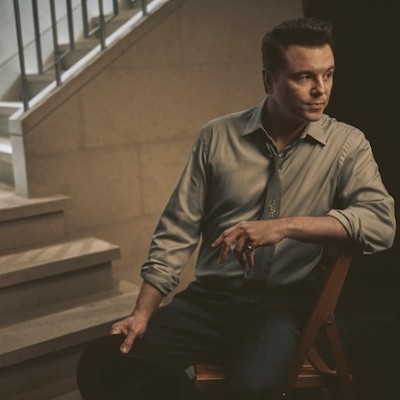Dec 9, 2025 12:28 PM
In Memoriam: Gordon Goodwin, 1954–2025
Gordon Goodwin, an award-winning saxophonist, pianist, bandleader, composer and arranger, died Dec. 8 in Los Angeles.…
For most of the summer Rocella Jonica is no different than scores of other seaside resorts along the Ionian coast at the southern tip of the Italian peninsula that cater to middle class families who spend their vacations there. Yet each year since 1980, over the course of four days at the end of August, Rumori Mediterranei (Sounds of the Mediterranean) transforms this sleepy beach community by presenting a visionary music festival that features some of the world’s leading jazz, fusion, world music and new music artists.
The 21st edition of Sounds of the Mediterranean, which took place August 22-25, featured an eclectic international roster that included groups led by the American bass guitarist Jamaaladeen Tacuma, the Danish percussionist Marilyn Mazur and the Senegalese singer Omar Pene and the Brazilian pianist-guitarist Egberto Gismonti who performed in a solo context. France’s Orchestre National de Jazz (ONJ), led by the Italian bassist and cellist Paolo Damiani, artistic director of the Rocella festival since its inception, appeared as well. The French woodwind virtuoso Louis Sclavis was the featured guest soloist with the ONJ and also performed with the quintet featuring cellist Vincent Courtois and bassist Bruno Chevillon that the visceral saxophonist and clarinetist featured on his latest recording, “L’affrontement des prétendants.” In addition to Damiani, Italy was represented by the jazz-influenced pop group Quintorigo, led by vocalist John De Leo, with trumpeter Enrico Rava joining them as a special guest.
Tacuma opened the festival with the world premiere of DJ-3, a new band he recently formed with drummer Jo Jo Mayer and electric guitarist David Fiuczynski. It was an auspicious debut. Taking a break from touring with the “Groove alla Turca” project, his funky world music collaboration with the Turkish percussionist Burhan Oçal’s Oriental Ensemble, Tacuma pulled out the stops and pumped up he volume in a power-trio format that paid stylistic tributes to artists as diverse as Coltrane and Cream.
Mazur’s Percussion Paradise, a quintet of female percussionists, made its Italian debut headlining the second night of the festival. A talented ensemble capable of keeping several intricate layers of mesmerizing ethnic rhythms going at once, the group’s over-choreographed routines—full of the kind of elfin dance steps one might imagine priestesses or virgins would execute in ancient moonlight rituals honoring Mother Earth—-came across as a bit too precious. One can appreciate Mazur’s intentions, but this concert came across as a kind of New Age cabaret show that ended up making a caricature of the very creative feminine spirit she hoped to celebrate.
Gismonti doesn’t tour much so the opportunity to hear this brilliant Brazilian composer, guitarist and pianist in concert was one of the most eagerly anticipated events of the festival. Before performing he conducted one of the series of workshops held in conjunction with Sounds of the Mediterranean and he also participated in a listening session at a high-end stereo shop in Rocella during which he previewed the recently released CD containing music he recorded in 1989 at the Montreal Jazz Festival in a duo concert with bassist Charlie Haden.
Gismonti’s spirituality, intellect, sense of humor and musicality come across in equal measures whether he’s engaging in an ad-lib question-and-answer session with his fans or performing on stage. During the course of his 90-minute set at Rocella he took an adoring audience on a fascinating musical tour of his multi-faceted homeland, playing a host of Brazilian melodies and rhythms—some of which he featured on his classic recordings “Sol do meio dia” and “Dança das Cabecas”—on grand piano, 10- and 12-string guitars and a home-made flute that looked as if it were hand-crafted by an Amazon Indian but was actually constructed by Gismonti from a simple piece of plastic tubing one can find in any hardware store

Goodwin was one of the most acclaimed, successful and influential jazz musicians of his generation.
Dec 9, 2025 12:28 PM
Gordon Goodwin, an award-winning saxophonist, pianist, bandleader, composer and arranger, died Dec. 8 in Los Angeles.…

Flea has returned to his first instrument — the trumpet — and assembled a dream band of jazz musicians to record a new album.
Dec 2, 2025 2:01 AM
After a nearly five-decade career as one of his generation’s defining rock bassists, Flea has returned to his first…

“It’s a pleasure and an honor to interpret the music of Oscar Peterson in his native city,” said Jim Doxas in regard to celebrating the Canadian legend. “He traveled the world, but never forgot Montreal.”
Nov 18, 2025 12:16 PM
In the pantheon of jazz luminaries, few shine as brightly, or swing as hard, as Oscar Peterson. A century ago, a…

Dec 11, 2025 11:00 AM
DownBeat presents a complete list of the 4-, 4½- and 5-star albums from 2025 in one convenient package. It’s a great…

Seth MacFarlane takes a turn from his television and film career to sing arrangements made for Frank Sinatra, but never recorded.
Nov 18, 2025 12:04 PM
“I’m not gonna lie to you — I don’t know why I thought this was about The Naked Gun, but I’m happy it’s…